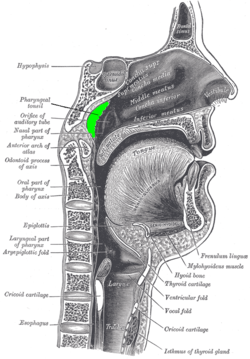This article needs additional citations for verification .(July 2016) |
| Adenoiditis | |
|---|---|
 | |
| Location of the adenoid | |
| Specialty | Otorhinolaryngology |
Adenoiditis is the inflammation of the adenoid tissue usually caused by an infection. Adenoiditis is treated using medication (antibiotics and/or steroids) or surgical intervention.
Contents
- Signs and symptoms
- Complications
- Cause
- Pathophysiology
- Diagnosis
- Treatment
- Epidemiology
- See also
- References
Adenoiditis may produce cold-like symptoms. However, adenoiditis symptoms often persist for ten or more days, and often include pus-like discharge from nose.
The infection cause is usually viral. However, if the adenoiditis is caused by a bacterial infection, antibiotics may be prescribed for treatment. A steroidal nasal spray may also be prescribed in order to reduce nasal congestion. Severe or recurring adenoiditis may require surgical removal of the adenoids (adenotonsillectomy).